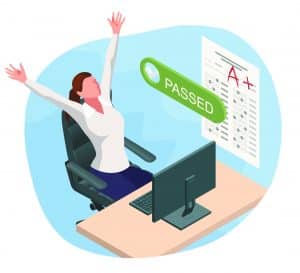Accuplacer Scores

❔ How is the Accuplacer scored?
The Next Generation Accuplacer has superseded the Classic Accuplacer. It means that most institutions nowadays require their applicants to take this version of the test. As an applicant, if you want to be placed in high-level classes, you must get good Accuplacer scores.
💯 Next Generation Accuplacer Scores
This Accuplacer placement test is composed of five tests: Next Generation Reading, Next-Generation Writing, Next-Generation Arithmetic, Next-Generation Quantitative Reasoning, Algebra, and Statistics, and Next-Generation Advanced Algebra and Functions. Each of the tests also has an Accuplacer score range of 200 to 300. The score range of 20 to 120 is for the Classic Accuplacer.
The Accuplacer Next Generation scoring is also further divided into 5 main score ranges:
- Score range: 236 and below
- Score range: 237–249
- Score range: 250–262
- Score range: 263–275
- Score range: 276 and above
Furthermore, your score report will also contain your numerical grades, which are based on your score ranges. Your scoring will be categorized under Low Score, Minimal Score, Basic Score, Sufficient Score, or Substantial Score.
There would be cases wherein you’ll have to talk with your school counselor to talk about your Accuplacer results. If you are not able to get your preferred score, then you might be advised to retake the test or take diagnostic tests. The diagnostic tests will help determine your performance in the content areas and know which parts to focus more on. You cannot actually pass or fail the test, but it can be very beneficial for you if you get high scores.
📝 What score do you need to pass the Accuplacer test?
There are no fixed Accuplacer passing scores. The passing score will be determined by the institution where you want to enroll and the course you prefer. Since the score requirements vary, it is important to check the admission requirements. This is so because you’ll know the target score you need to get into the class that you want.

💭 Where can I get my Accuplacer test scores?
The Accuplacer is a computerized test system, which means that applicants will receive their college placement test scores after they complete the exam. The score reports are then provided by the institution where it was taken.
🤔 Accuplacer Questions
How to get perfect scores on math tests?
If you are planning to take the Accuplacer Math and you want to ace it, the best thing that you should do is to study well and practice. Solving mathematical problems will require critical and analytical skills, which means that your priority is honing them to get great Accuplacer Math scores. You can take a free practice college placement test online or Accuplacer math test prep to get ready, for example. Getting a perfect score is not completely impossible, but it will require a lot of hard work on your part.

How to skip Precalculus and go straight to AP Calculus?
You can try taking the Accuplacer exam. It’s a placement test that’ll help determine which college-level classes you belong to. You can skip Precalculus if it shows that you have the required knowledge and skill to be placed in that class.
What are placement tests like for community colleges in the USA?
The requirements for the placement tests differ for each state. That’s why you should check first what is needed for you to take the tests. The Accuplacer program, for that matter, is used by various colleges and universities. You must know the passing sores or the Accuplacer test scores percentiles to know the preparations you’ll have to do to pass. You can get help passing these tests through college placement test preps, placement test study guides, or free Accuplacer practice tests.
Are the GED and the College Placement Test the same thing?
The General Education Development is different from college placement tests like the Accuplacer. It is a series of tests that will determine whether you have a high school level education or not. Furthermore, passing the GED will be equivalent to getting your high school diploma. To be able to take the GED, you must be at least 16 years old and cannot enroll in a high school.
On the other hand, to answer the question, “What is a college placement test?”, college placement tests are those taken by high school students in order to enroll in some institutions which require the test. Through college placement tests, students will be able to take college-level courses that are appropriate for them. These tests are very helpful when it comes to knowing whether an applicant is both academically and career ready.
How can you pass Accuplacer writing test?
The ACCUPLACER writing subtest is a computer-adaptive, untimed, broad-spectrum test. It was created to aid in the accurate placement of students into appropriate level classes by evaluating their individual capabilities in two broad knowledge and skill categories.
These are some tactics and tips to help you conquer the Accuplacer writing section.
- You need to take a firm stance.
- Don’t move from your stance.
- Make your point as specific as possible.
- Incorporate a rebuttal argument.
- Make the opening and ending as brief as possible.
- Make use of transitional words.
How to check Accuplacer scores?
Visit https://studentportal.accuplacer.org/ for further information. in order to have access to the ACCUPLACER Student Portal Select “Your ACCUPLACER Score Report” from the drop-down menu. Enter the same information you did when you took your test on the “Find Your Test Results” screen, then click the “Search” button.
What is a reading placement test?
Reading Placement Tests are intended to help students determine if they are ready to read most college-level materials. The ACCUPLACER® Next Generation Reading Comprehension test will be given to students who self-identify as native English speakers. The ACCUPLACER® ESL Sentence Meaning and ESL Reading Comprehension assessments will be given to students who self-identify as English as a second language speakers.
Neither of the two versions is more challenging. The idea is to place each person in the class that best suits their needs.
Because these tests are not timed, take your time reading the questions, answer options, and passage. The majority of testers finish the test in 45 minutes to an hour.